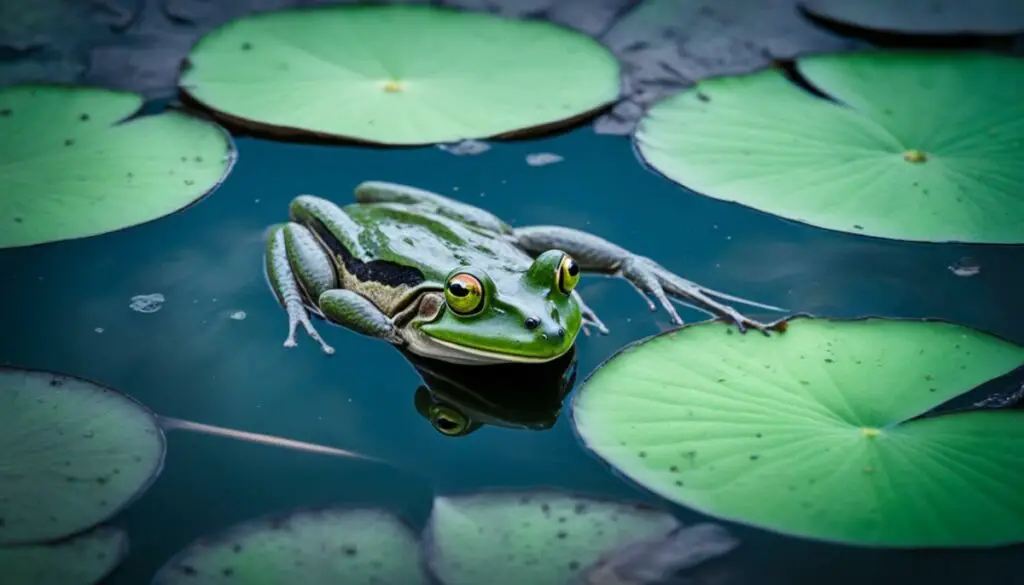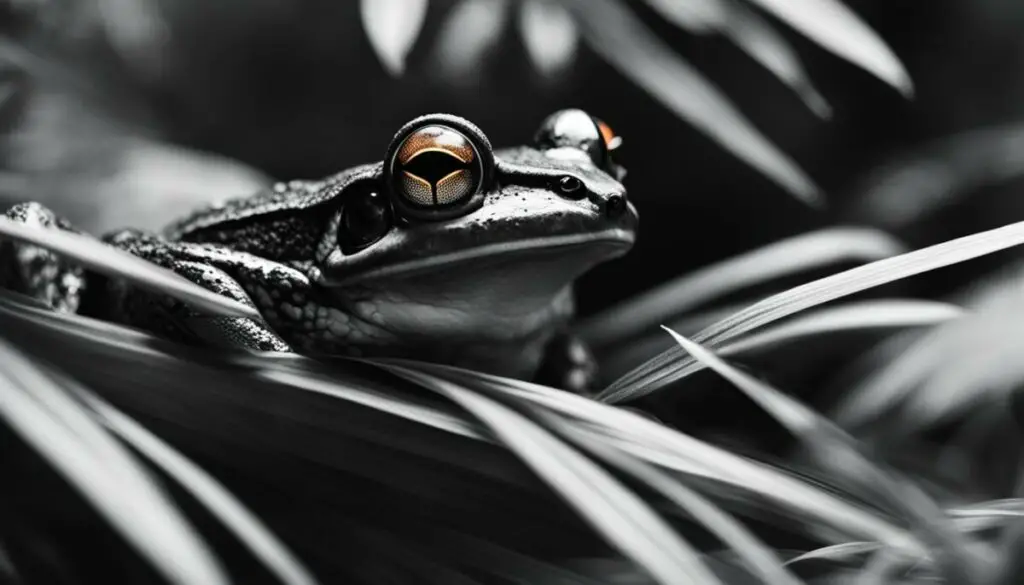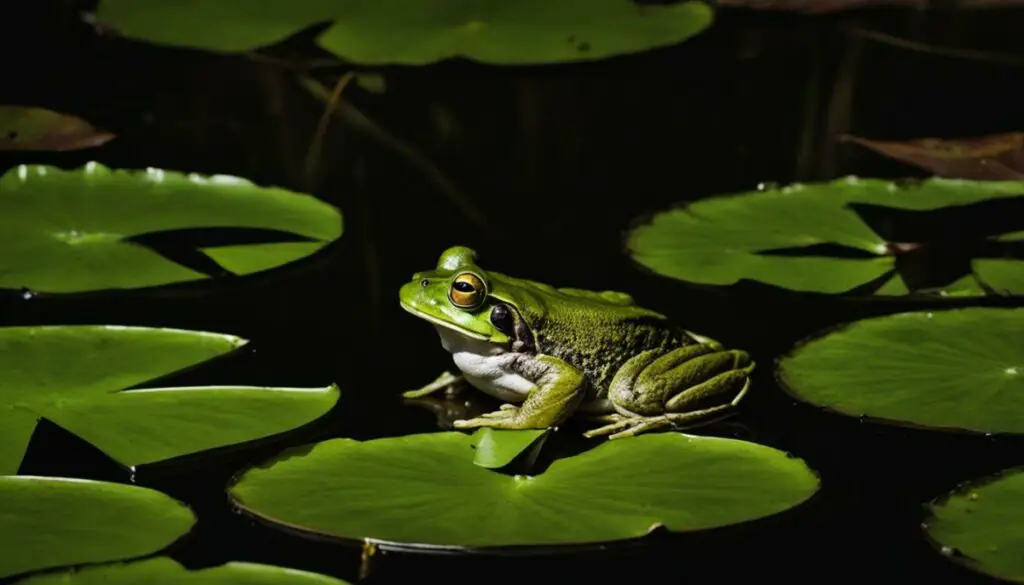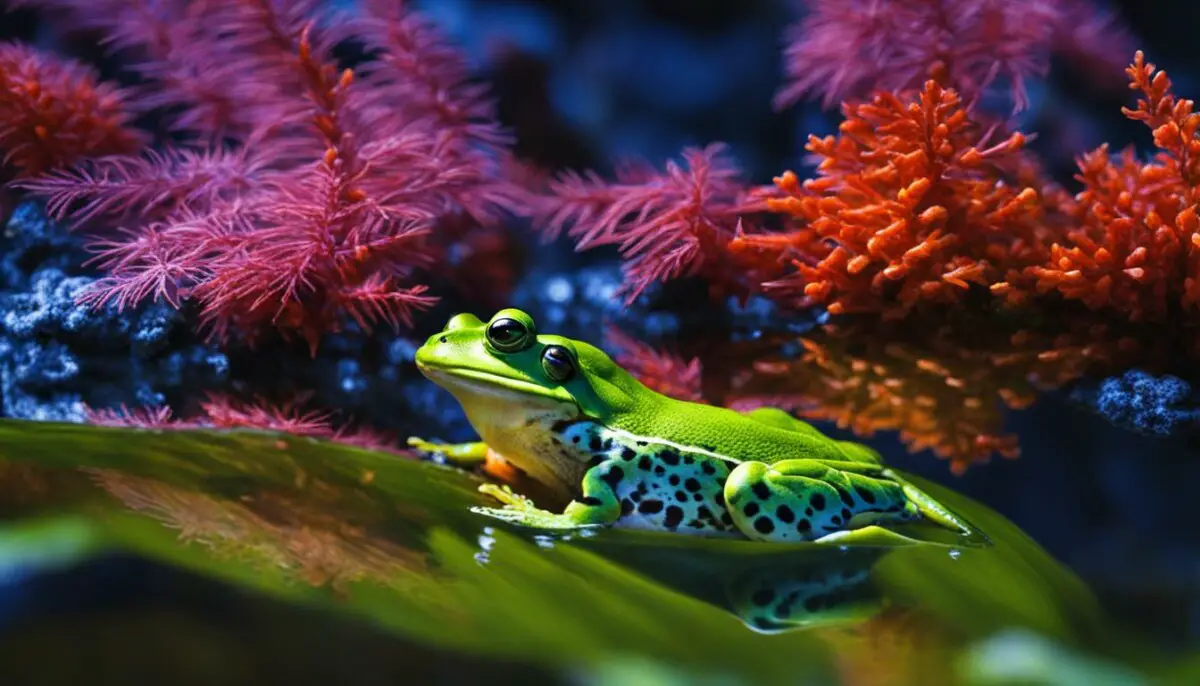Last Updated on 4 months by Francis
When it comes to vision, frogs possess a remarkable ability that sets them apart from humans and other animals. They have the capability to see infrared light, which is invisible to the human eye. This unique trait has puzzled scientists for years and has opened up a world of possibilities for understanding the visual perception of these fascinating amphibians.
Frogs have specialized photoreceptors in their eyes that allow them to detect individual photons and be more sensitive to low levels of light. Unlike humans, whose vision is not capable of detecting single photons, frogs can trigger their photoreceptors with individual photons, enabling them to see in dimly lit environments.
But what about infrared light? Can frogs really see it? Studies have shown that frogs have the ability to perceive infrared light through their retinas. While human retinas are not sensitive to infrared light, the photoreceptors in frogs’ eyes are triggered by these wavelengths, allowing them to detect and respond to this type of light.
Contents
Key Takeaways:
- Frogs have specialized photoreceptors in their eyes that allow them to detect individual photons and be more sensitive to low levels of light.
- Unlike humans, frogs can perceive infrared light through their retinas, thanks to their photoreceptors.
- The ability of frogs to see infrared light opens up new possibilities for understanding their visual perception and adaptations.
- Further research is needed to fully comprehend the mechanisms behind frog vision and the ecological implications of their ability to detect infrared light.
- Studying frog vision contributes to our understanding of the unique adaptations and abilities of these fascinating amphibians.
How Do Frogs Detect Infrared Light?

Frogs possess a remarkable ability to detect infrared light through their retinas, a capability that human retinas lack. These extraordinary amphibians have specialized photoreceptors that are triggered by the wavelengths of infrared light. Although the precise mechanisms by which frogs detect and process infrared light are not yet fully understood, ongoing research aims to unveil the secrets behind this fascinating ability.
Some frog species, including the red-eyed tree frog and the white’s tree frog, exhibit high reflectivity in the near infrared range of the spectrum. This increased reflectivity may serve as a form of camouflage, offering protection from predators or prey that possess extended vision in the infrared range.
Further investigation into the mechanisms underlying frogs’ ability to detect and respond to infrared light may shed light on the specific adaptations within their retinas and photoreceptors. By unraveling these mysteries, researchers can gain a deeper understanding of the unique visual capabilities of frogs and their remarkable survival strategies.
The Infrared Vision of Frog Species
Among the diverse array of frog species, certain ones have been identified as possessing infrared vision. Notably, the red-eyed tree frog and the white’s tree frog demonstrate high reflectivity in the near infrared range of the spectrum. This characteristic may contribute to their ability to conceal themselves within their environment, which could enhance their chances of evading detection by predators or capturing prey that rely on infrared vision.
“The ability of certain frog species to visually detect infrared light opens up a world of possibilities for understanding the evolution and ecological significance of these amazing creatures.” – Dr. Jane Reynolds, Frog Vision Researcher
Uncovering the Secrets of Frog Vision
Despite significant progress, there is still much to learn about the complex mechanisms through which frogs detect and process infrared light. Ongoing research endeavors continue to explore the physiological and neural intricacies underlying this unique visual ability. By delving deeper into the retinas and photoreceptors of frogs, scientists hope to gain valuable insights into the adaptations that equip them with this extraordinary power.
The study of frog vision has far-reaching implications, not only for our understanding of these fascinating creatures but also for the potential development of innovative technologies inspired by nature’s design. By unlocking the secrets of frog vision, researchers may uncover new possibilities for applications in fields such as surveillance, medical imaging, and robotics.
The Role of Frog Visual Perception

Frog visual perception plays a crucial role in their ability to detect and respond to their environment. Frogs have specialized photoreceptors in their eyes that allow them to perceive light and differentiate between different wavelengths. This sensitivity to different wavelengths, including infrared light, enables frogs to navigate their surroundings, find food, and avoid danger. The ability to perceive infrared light may also have implications for their reproductive behavior, as studies have shown that visual stimuli, including color perception, play a role in the mating behavior of some frog species. Further research is needed to fully understand the extent of frog visual perception and its role in their survival and reproduction.
Frogs rely on their visual perception to interact with their environment, making it one of their most vital senses. Their specialized photoreceptors are capable of detecting and analyzing different wavelengths of light, allowing them to process visual information in a way that is different from human vision. This unique ability gives frogs a distinct advantage in their natural habitat, enabling them to locate prey, avoid predators, and navigate their surroundings effectively.
One fascinating aspect of frog visual perception is their sensitivity to infrared light. While human vision is limited to the visible light spectrum, frogs have the remarkable ability to detect and respond to infrared light. This sensitivity to infrared light is thought to be influenced by their specialized photoreceptors, which are triggered by specific wavelengths of light, including those in the infrared range. This ability allows frogs to perceive objects and sources of heat that are not visible to the human eye.
The sensitivity to infrared light in frogs has significant implications for their survival and reproductive behavior. Infrared light is often associated with heat, making it a valuable cue for frogs to identify potential sources of food or detect the presence of predators. Frogs that are able to detect and respond to infrared light have a greater advantage in locating prey or avoiding danger in their environment.
Furthermore, studies have shown that visual stimuli, including color perception, play a role in the mating behavior of some frog species. The ability to perceive different colors, including infrared, may influence mate selection and courtship rituals. This suggests that frog visual perception, including their sensitivity to infrared light, is not only essential for survival but also plays a crucial role in their reproductive success.
Despite the advancements in our understanding of frog visual perception, there is still much to learn about the extent of their abilities and the specific mechanisms through which they perceive and process different wavelengths of light. Further research is needed to unravel the complexities of frog visual perception and its role in their survival, reproduction, and overall ecological adaptations.
The Physiology of Frog Vision

The physiology of frog vision is a fascinating subject that involves various components, including the retinas, visual pigments, and photoreceptors. In frogs, the retinas are equipped with specialized cells called photoreceptors, which are responsible for detecting light and converting it into electrical signals for the brain to process.
These remarkable photoreceptors contain visual pigments, such as rhodopsin, that are sensitive to different wavelengths of light. These visual pigments enable frogs to perceive and respond to various light conditions, including infrared light.
The specific mechanisms by which these visual pigments and photoreceptors work together to enable frog vision are still under investigation. Scientists are conducting extensive research to gain a deeper understanding of how these intricate physiological processes contribute to the remarkable visual abilities of frogs.
Research on frog retinas, visual pigments, and photoreceptors is shedding light on the complex nature of frog vision and its unique adaptations. By studying these physiological aspects, researchers hope to uncover more insights into the incredible vision of frogs and its significance in their survival and reproduction.
The Evolutionary Significance of Infrared Vision in Frogs

The ability of frogs to perceive and respond to infrared light holds significant evolutionary implications that continue to intrigue researchers. Although the exact reasons for this ability and its evolutionary benefits are not yet fully understood, several hypotheses have been proposed.
- One hypothesis suggests that the increased reflectivity of certain frog species in the near infrared range serves as a form of camouflage, providing protection against predators or prey equipped with extended vision in this range.
- Another hypothesis proposes that the sensitivity to infrared light enhances frogs’ ability to navigate their environments and locate food sources more efficiently.
To fully comprehend the evolutionary significance of infrared vision in frogs, further research and investigation into frog vision and its evolutionary history are essential. By examining the unique adaptations and abilities of frogs, we can gain deeper insights into the fascinating world of amphibian eyesight.
Studies on the diverse frog species and their vision mechanisms contribute to our knowledge of the intricate evolutionary processes that have shaped their visual systems. Exploring the connections between infrared vision and the survival and reproduction of frogs offers exciting prospects for uncovering the intricate ecological adaptations associated with this unique ability.
The Spectral Reflectivity of Frog Integument

The spectral reflectivity of frog integument, or the ability of their skin to reflect different wavelengths of light, plays a crucial role in their visual perception and their ability to detect infrared light. Research studies have revealed that different frog species exhibit variations in spectral reflectivity, particularly in the near infrared range. For instance, the red-eyed tree frog and the white’s tree frog have been found to have high reflectivity in the near infrared range.
This reflectivity in frog integument may be influenced by various factors, including pigmentation and the structural organization of reflecting platelet layers in the skin. These factors contribute to the unique ability of frogs to efficiently utilize and respond to infrared light in their environment.
“Frog integument exhibits remarkable variations in spectral reflectivity, particularly in the near infrared range, which allows them to effectively utilize and respond to infrared light.”
Spectral Reflectivity in Frog Integument:
| Frog Species | Spectral Reflectivity in Near Infrared Range |
|---|---|
| Red-eyed tree frog | High reflectivity |
| White’s tree frog | High reflectivity |
| Other frog species | Varies |
Hyperspectral imaging techniques have been instrumental in studying and analyzing the reflectivity patterns of frog integument. These advanced imaging methods capture images across a wide range of wavelengths with high spectral and spatial resolution. By examining the reflectivity patterns of frog integument, researchers gain insights into the visual capabilities and adaptations of different frog species. Hyperspectral imaging enables a deeper understanding of how frogs utilize spectral reflectivity to detect and respond to infrared light in their natural habitats.
Hyperspectral Imaging for Studying Frog Skin Reflectivity

Hyperspectral imaging is a valuable tool for analyzing frog skin reflectivity and understanding the spectral characteristics of frog integument. This imaging technique utilizes dual camera setups to capture reflectance images across a wide range of wavelengths, providing high spectral and spatial resolution. With hyperspectral imaging, researchers can investigate the reflectivity patterns of frog skin in the visible, near infrared, and short wave infrared parts of the spectrum.
By employing hyperspectral imaging, scientists gain insights into the variations in reflectivity among different frog species. This non-invasive method allows for the characterization of the spectral properties of frog skin, contributing to our understanding of the unique visual capabilities of these amphibians.
In laboratory settings and field studies where traditional imaging methods may be challenging to employ, hyperspectral imaging offers an efficient and effective means of studying frog integument. It enables researchers to analyze and compare reflectivity patterns, aiding in the identification of potential camouflage mechanisms and adaptive visual features exhibited by frog species.
When conducting hyperspectral imaging studies, researchers employ a range of wavelengths that cover the visible spectrum as well as the near infrared and short wave infrared parts of the electromagnetic spectrum. This comprehensive approach provides a detailed assessment of frog skin reflectivity and its potential influence on their visual perception and ecological interactions.
In summary, hyperspectral imaging is a powerful technique that enables comprehensive analysis of frog skin reflectivity. By utilizing this imaging method, researchers can uncover valuable insights into the spectral characteristics of frog integument and gain a deeper understanding of the unique visual abilities of these fascinating amphibians.
| Advantages of Hyperspectral Imaging for Studying Frog Skin Reflectivity | Limitations of Hyperspectral Imaging for Studying Frog Skin Reflectivity |
|---|---|
|
|
The Significance of Infrared Reflectivity in Frog Integument
The significance of infrared reflectivity in frog integument is still a subject of investigation. Researchers are exploring how increased reflectivity in the near infrared range plays a crucial role for frogs in their natural habitats.
One hypothesis suggests that the heightened reflectivity in this range may provide camouflage and protection for frogs in environments with high infrared reflectivity, such as green vegetation. By blending in with their surroundings, frogs can avoid detection by predators or prey that have extended vision in the infrared range, giving them a survival advantage.
Understanding the specific mechanisms and ecological implications of infrared reflectivity in frog integument requires further research. By delving deeper into this unique adaptation, scientists hope to gain insights into the fascinating world of frog vision and its influence on their behavior and survival.
“The heightened reflectivity in the near infrared range may provide camouflage and protection for frogs.”
Digital Infrared/Red-Edge Photography for Assessing Frog Reflectivity

Digital infrared/red-edge photography is a powerful technique for assessing the reflectivity patterns in the near infrared range of the spectrum in frogs. By using cameras that are sensitive to infrared light, this method captures images that reveal differences in reflectivity among frog species, providing valuable insights into their ability to detect and respond to infrared light.
This non-invasive technique complements the data obtained from hyperspectral imaging and can be particularly useful in field studies where traditional imaging methods may be challenging to implement.
Incorporating digital infrared/red-edge photography allows researchers to analyze the unique reflectivity properties of frog integument in a simple and efficient manner. This technique enhances our understanding of frog vision and their adaptation to different environments.
In addition to capturing detailed imagery, digital infrared/red-edge photography offers the opportunity for creating comparative analyses, identifying variations in reflectivity, and interpreting the ecological implications of these patterns.
The Role of Frog Vision in Survival and Reproduction
Frog vision is instrumental in enabling these amphibians to thrive and reproduce. Their keen visual perception allows them to effectively navigate their surroundings, locate sources of food, and evade potential predators. Additionally, their sensitivity to light wavelengths, including the near infrared range, plays a crucial role in their reproductive behavior.
The ability of frogs to detect and respond to different visual stimuli, including infrared light, grants them a competitive edge in their natural habitat. Their acute vision enables them to spot potential threats and take evasive action, ensuring their survival in challenging environments.
Furthermore, research has shown that visual stimuli and color perception have a direct influence on the mating behavior of certain frog species. The ability to perceive and respond to different wavelengths of light, such as infrared, may play a significant role in their choice of potential mates and the success of their reproductive efforts.
“Frog vision is not only a means of survival, but also a key driver of their reproductive success.”
Understanding the role of frog vision in both their survival and reproduction sheds light on the remarkable adaptability and behaviors of these fascinating creatures. By honing their visual capabilities to detect and respond to various visual cues, including infrared light, frogs have developed a unique advantage in their ecological niche.
The Significance of Frog Vision in Survival
Frog vision is an essential tool for survival in their natural habitats. Their ability to detect and respond to visual stimuli, such as the presence of predators or opportunities for food, allows frogs to make informed decisions that enhance their chances of survival. By utilizing their visual acuity, frogs can swiftly navigate their environment, avoiding potential dangers and improving their overall well-being.
The Role of Frog Vision in Reproduction
Frog vision also plays a crucial role in their reproductive processes. Visual stimuli, including color perception, are known to influence the mating behavior of certain frog species. The ability to differentiate between various wavelengths of light, including infrared, can impact their mate selection and overall reproductive success. The unique visual capabilities of frogs have evolved to support their reproductive strategies, ensuring the continuation of their species.
Overall, the vital role of frog vision in their survival and reproduction highlights the remarkable adaptability and ecological significance of these amphibians. Their keen visual perception, including the ability to detect and respond to infrared light, grants them a distinct advantage in their natural habitats.
| Role | Importance |
|---|---|
| Survival | Crucial for navigating the environment and avoiding threats |
| Reproduction | Influences mate selection and overall reproductive success |
The Future of Research on Frog Vision
While significant progress has been made in understanding frog vision, there are still numerous unanswered questions and exciting avenues for future research. Advancements in imaging techniques, such as hyperspectral imaging and digital infrared/red-edge photography, present new opportunities for studying and unraveling the visual capabilities of frogs.
Hyperspectral imaging, with its high spectral and spatial resolution, allows researchers to examine the reflectivity patterns of frog integument across a wide range of wavelengths. This non-invasive technique provides valuable insights into the spectral characteristics of frog skin and the variations in reflectivity among different species. By further exploring the spectral reflectivity of frog integument, researchers can shed light on the visual perception and adaptations of these remarkable amphibians.
Digital infrared/red-edge photography is another useful tool for assessing frog reflectivity, particularly in the near infrared range of the spectrum. This technique captures images using infrared-sensitive cameras, revealing differences in reflectivity among frog species and providing valuable information about their ability to detect and respond to infrared light. Digital infrared/red-edge photography complements hyperspectral imaging and offers a simple yet effective method for studying frog reflectivity, especially in field studies where traditional imaging methods may be challenging to implement.
Elucidating the Mechanisms of Frog Vision
One of the key areas for future research on frog vision is understanding the specific mechanisms through which frogs detect and process infrared light. Despite the progress made in uncovering the physiological aspects of frog vision, many details remain elusive. Investigating the intricate interplay between the retinas, visual pigments, and photoreceptors in frog eyes can provide valuable insights into how these amphibians perceive and interpret different wavelengths of light, including infrared.
Unraveling the Ecological Implications and Evolutionary Significance
Exploring the ecological implications of infrared vision in frogs is another important direction for future research. Understanding how this unique visual ability influences the survival, behavior, and interactions of frogs with their environment can provide valuable insights into their adaptations and evolution. Investigating the evolutionary significance of infrared vision can shed light on the selective pressures that have shaped this extraordinary visual capability in frogs.
| Advancements in Studying Frog Vision | Future Research Directions |
|---|---|
| Hyperspectral Imaging | Elucidating the mechanisms of frog vision |
| Digital Infrared/Red-Edge Photography | Unraveling the ecological implications and evolutionary significance |
Continued research in these areas holds great promise for expanding our understanding of frog vision and the intriguing world of amphibian eyesight. Through innovative imaging techniques, comprehensive studies on spectral reflectivity, and investigations into the mechanisms and ecological significance of infrared vision, researchers can uncover the hidden secrets of frog vision and gain deeper insights into the amazing capabilities of these fascinating creatures.
Conclusion
In conclusion, frogs possess an extraordinary ability to detect and respond to infrared light, thanks to their specialized photoreceptors and visual pigments in their eyes. Research has revealed that certain frog species exhibit a heightened reflectivity in the near infrared range, serving as an effective camouflage and protection mechanism against predators or prey with extended vision in this spectrum.
Effective tools such as hyperspectral imaging and digital infrared/red-edge photography have proven valuable in the study and analysis of the spectral reflectivity patterns in frog integument. These techniques enable researchers to delve deeper into understanding the mechanisms and ecological implications of infrared vision in frogs and its potential role in their survival and reproduction.
Further research is warranted to fully comprehend the intricacies of how frogs detect and process infrared light, as well as the impact it has on their overall ecosystem. The study of frog vision not only sheds light on their remarkable adaptations and abilities but also contributes to a broader understanding of the mesmerizing world of amphibians and their remarkable visual perception.
FAQ
Can frogs see infrared light?
Yes, frogs have the ability to detect and respond to infrared light.
How do frogs detect infrared light?
Frogs detect infrared light through specialized photoreceptors in their eyes.
What is the role of frog visual perception?
Frog visual perception plays a crucial role in their ability to navigate their environment and find food.
What is the physiology of frog vision?
The physiology of frog vision involves their retinas, visual pigments, and photoreceptors in their eyes.
What is the evolutionary significance of infrared vision in frogs?
The evolutionary significance of infrared vision in frogs is still being studied and debated.
What is the spectral reflectivity of frog integument?
The spectral reflectivity of frog integument refers to the ability of their skin to reflect different wavelengths of light.
How is hyperspectral imaging used for studying frog skin reflectivity?
Hyperspectral imaging is a valuable tool for analyzing the spectral reflectivity patterns of frog integument.
What is the significance of infrared reflectivity in frog integument?
The significance of infrared reflectivity in frog integument is still a subject of investigation.
How is digital infrared/red-edge photography used for assessing frog reflectivity?
Digital infrared/red-edge photography is a technique used to assess the reflectivity patterns in the near infrared range of the spectrum in frogs.
What is the role of frog vision in their survival and reproduction?
Frog vision plays a crucial role in their survival and reproduction by enabling them to navigate their environment and find suitable mates.
What is the future of research on frog vision?
Further research is needed to fully understand the mechanisms and ecological implications of infrared vision in frogs, as well as its role in their survival and reproduction.
Conclusion
Studying frog vision provides insights into the incredible adaptations and abilities of these fascinating amphibians, but there is still much to learn and discover.









